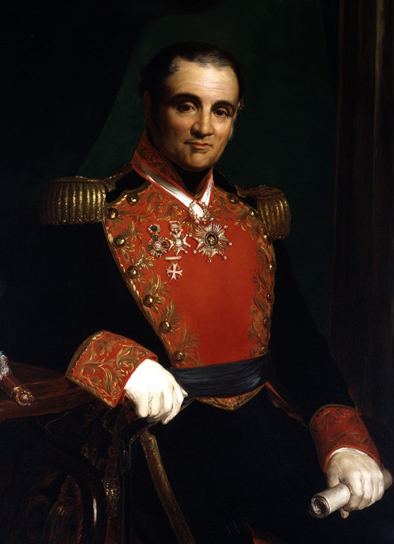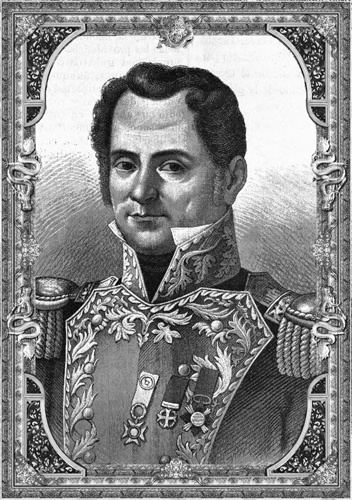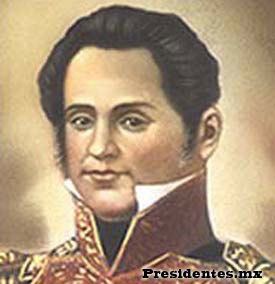Vice President Himself Preceded by Nicolas Bravo Preceded by Pedro Velez Name Anastasio Bustamante | Succeeded by Melchor Muzquiz Preceded by Jose Justo Corro | |
 | ||
Succeeded by Antonio Lopez de Santa Anna Similar People Manuel Gomez Pedraza, Valentin Gomez Farias, Antonio Lopez de Santa An, Pedro Velez, Vicente Guerrero | ||
Anastasio bustamante lucas alam n melchor m zquiz masones
Anastasio Bustamante y Oseguera ([anasˈtasjo βustaˈmante]; 27 July 1780 – 6 February 1853) was president of Mexico three times, from 1830 to 1832, from 1837 to 1839 and from 1839 to 1841. He was a Conservative. He first came to power by leading a coup against president Vicente Guerrero. Bustamante was deposed twice and exiled to Europe each time.
Contents
- Anastasio bustamante lucas alam n melchor m zquiz masones
- Anastasio bustamante
- Early life
- The First Empire
- First term
- Second term
- Third term
- Later career
- References

Anastasio bustamante
Early life

Anastasio Bustamante's father, José María, worked hauling snow from the volcanoes of Colima to Guadalajara, but was able to provide his son with a good education. At 15, the younger Bustamante entered the Seminary of Guadalajara. When he finished, he went to Mexico City to study medicine. He passed his medical examinations and then went to San Luis Potosí as director of San Juan de Dios Hospital.
In 1808, he entered the royal army as a cavalry officer under the command of Félix María Calleja. In 1810, General Calleja mobilized the army to fight the rebels under Miguel Hidalgo, and Bustamante participated on the royalist side in all the actions of the Army of the Center. During the War of Independence, he rose to the rank of general. He supported royalist-turned-insurgent Agustín de Iturbide and the Plan of Iguala. When Iturbide was declared emperor of Mexico, Bustamante continued his support, as did many other conservative elites who saw centralized, monarchical government as the optimal government for independent Mexico.
The First Empire

On 19 March 1821, in support of Agustín de Iturbide (a personal friend), Bustamante proclaimed the independence of Mexico from Spain at Pantoja, Guanajuato. A few days later, he removed the remains of the 1811 insurgent leaders from the Alhóndiga de Granaditas in Guanajuato and had them buried in San Sebastián cemetery.

Iturbide named him commander of the cavalry, second in command of the Army of the Center, and a member of the governing junta. The Regency named him field marshal and captain general of the Provincias Internas de Oriente y Occidente, effective 28 September 1821. He fought and defeated a Spanish expeditionary force at Xichú.

At the fall of the Empire in 1823, he joined the ranks of the federalists, for which he was arrested and confined at Acapulco, but President Guadalupe Victoria again put him in command of the Provincias Internas.
First term

In December 1828, under the Plan de Perote, Congress named him vice-president of the Republic under President Vicente Guerrero. He took possession of this office on 1 April 1829 but soon was at odds with Guerrero. On 4 December 1829, in accord with the Plan de Jalapa, he rose against Guerrero, driving him from the capital. On 1 January 1830, he assumed the presidency on an interim basis. Congress declared Guerrero "incapable of governing".
In office, Bustamante removed employees not having the confidence of "public opinion". He instituted a secret police force and took steps to suppress the press. He exiled some of his competitors and expelled U.S. Minister Joel Poinsett. He was involved in the kidnapping and execution of his predecessor, Guerrero. He supported industry and the clergy.
These and other policies stimulated opposition, especially in the states of Jalisco, Zacatecas, and Texas. In 1832, a revolt broke out in Veracruz. The rebels asked Antonio López de Santa Anna to take command. When their immediate demands were met (the resignation of some of Bustamante's ministers), they also demanded the president's ouster. They intended to replace him with Manuel Gómez Pedraza, whose 1828 election had been annulled.
Bustamante turned over the presidency to Melchor Múzquiz on 14 August 1832 and left the capital to fight the rebels. He defeated them on 14 August at Gallinero, Dolores Hidalgo, Guanajuato, and then returned to fight Santa Anna, who was nearing Puebla. After two more battles, the three candidates, Bustamante, Santa Anna and Gómez Pedraza, signed the Agreements of Zavaleta (21–23 December), by which Gómez Pedraza was to assume the presidency and hold new elections. Bustamante was to go into exile, which he did in 1833.
Second term
While in exile in France he inspected military and medical facilities. He returned to Mexico in December 1836, called back by President José Justo Corro to fight in the War of Texas Independence. However, once he was back in the country, Congress declared him president (17 April 1837).
With the treasury exhausted and the army depleted by a series of revolts, Bustamante was limited in his military response to crises. France issued an ultimatum on 21 March 1838, and on 16 April began blockading Mexico's Gulf ports. The French declared war on 27 November 1838 (the Pastry War), bombarded San Juan de Ulúa, and occupied Veracruz (5 December).
About the same time, Guatemalan general Miguel Gutiérrez invaded Chiapas. Bustamante temporarily left the presidency from 20 March to 18 July 1839 to campaign against rebel General José Urrea in Tamaulipas. Santa Anna and Nicolás Bravo served as president during this absence.
Third term
He became president again on 9 July 1839, serving until 22 September 1841. During this term, the first Spanish diplomatic representative to Mexico, Ángel Calderón de la Barca y Belgrano, arrived. The boundary between Yucatán and Belize was established. Treaties were signed with Belgium and Bavaria, and relations with the United States were reestablished.
On 15 July 1840, General Urrea escaped from prison and led a force against Bustamante in the National Palace. Bustamante resisted, but on the 16th he was forced to flee, accompanied by 28 dragoons. During this siege artillery destroyed the southeast corner of the Palace. He did not relinquish the presidency, however.
About this time a revolt broke out in Yucatán.
In August 1841, Santa Anna and Paredes, military commanders of Veracruz and Jalisco, launched a new rebellion against Bustamante. He turned the government over to Francisco Javier Echeverría on 2 September 1841. Echeverría lasted only until 10 October, when Santa Anna returned to the presidency.
Later career
Bustamante again went into exile in Europe, spending time in France and Italy. His aide-de-camp José María Calderón y Tapia, as well as his nephew Andrés Oseguera, accompanied Bustamante in Europe. He traveled widely and sought medical treatment, taking the waters at Contrexéville, France. He returned to Mexico in 1845 to offer his services in the crisis with the United States. In 1846, he was president of Congress. That year he was named general of an expedition to defend the Californias from the United States, but he was unable to reach California for lack of resources. In 1848, he suppressed rebellions in Guanajuato and Aguascalientes.
He lived the latter part of his life in San Miguel de Allende, where he died in 1853 at the age of 72. His heart was placed in the Mexico City Cathedral's chapel of San Felipe de Jesús alongside the ashes of Emperor Iturbide.
